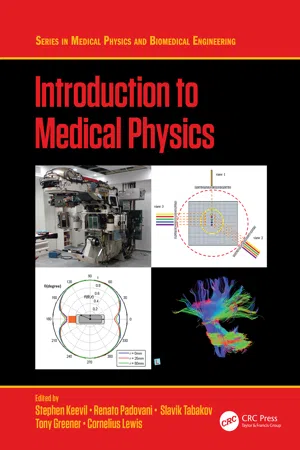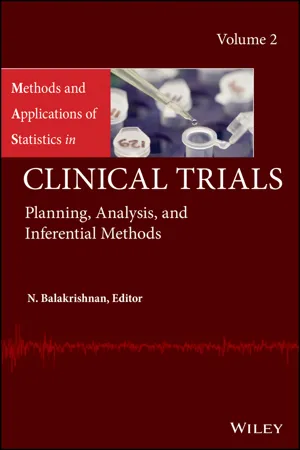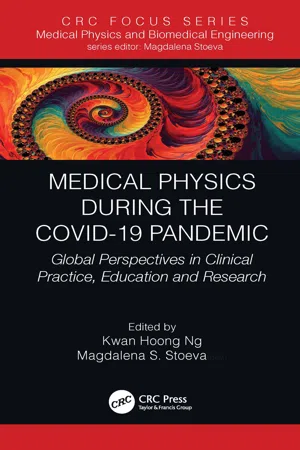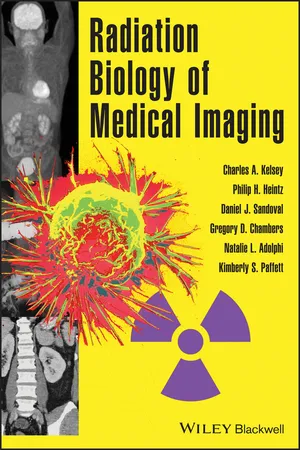Physics
Medical Physics
Medical Physics is a branch of physics that applies the principles and methods of physics to the diagnosis and treatment of human diseases. It involves the use of radiation, imaging techniques, and other technologies to improve medical care. Medical physicists work closely with healthcare professionals to ensure the safe and effective use of these technologies in clinical settings.
Written by Perlego with AI-assistance
Related key terms
Related key terms
1 of 4
Related key terms
1 of 3
6 Key excerpts on "Medical Physics"
- eBook - ePub
- Stephen Keevil, Renato Padovani, Slavik Tabakov, Tony Greener, Cornelius Lewis(Authors)
- 2022(Publication Date)
- CRC Press(Publisher)
1 Medical Physics, an Introduction Perry Sprawls Emory University, Atlanta, USADOI: 10.1201/9780429155758-1Contents- 1.1 Introduction
- 1.2 Medical Physicists
- 1.3 Physics and Medicine
- 1.4 The Diagnostic Process
- 1.5 The Therapeutic Process
- 1.6 Areas of Physics
- 1.7 Ionising Radiation
- 1.8 Medical Physics and Innovations in Technology
- 1.9 Medical Imaging for Diagnosis
- 1.9.1 The Discovery and the Beginning
- 1.9.2 The Quest for Extended Visibility
- 1.9.3 Imaging Methods or Modalities
- 1.10 Radiation Therapy
- 1.10.1 Treatment Planning and Requirement for Precision
- 1.10.2 Radium and the Origin of Radiation Therapy
- 1.11 Other Physics-Based Medical Applications
- 1.12 Radiation Safety and Risk Management
- 1.13 Conclusion
1.1 IntroductionPhysics, along with biology, chemistry and psychology, is one of the basic sciences that are the foundation of medicine. Physics is especially significant because the human body is a physical environment and system. It is within the physical body that all of the other scientifically based functions take place producing and supporting life.Medicine is the comprehensive science and practice of diagnosing, treating or preventing disease and other damage to the human body and mental system. This is usually achieved by interacting with the different scientifically based functions within the body. For example, infections are biological events and poison is a chemical condition. These would generally be diagnosed and treated based on those sciences.Because the structure, composition and many functions of the human body are physical, physics is the basic science for the diagnosis and treatment of many conditions and is the foundation of the profession of Medical Physics.1.2 Medical PhysicistsMedical physicists are professionals with a strong academic background in general physics, Medical Physics topics and other medically related subjects including anatomy, physiology and pathology. They work in research and development, education and clinical Medical Physics. Clinical medical physicists generally have academic degrees in Medical Physics, supervised work experience (for example a residency programme in the US or the UK Scientist Training Programme (STP)), and are certified by regulatory bodies or professional organisations. - eBook - ePub
Clinical Imaging Physics
Current and Emerging Practice
- Ehsan Samei, Douglas E. Pfeiffer(Authors)
- 2020(Publication Date)
- Wiley-Blackwell(Publisher)
Introduction
Medical imaging is a cornerstone of healthcare. A technology that was initially grown from a physics experiment, medical imaging has been developed and advanced over decades by medical physicists who have played central roles in the development and the practice of the discipline. In a period of just over a century, Medical Physics has brought rapid growth and continuous innovation to the presence of imaging in medicine. While innovative technologies have offered enhanced opportunities for high‐quality imaging care, optimized and evidence‐based use of these advanced technologies cannot be assumed. Thus, clinically, physicists have also played key roles in ensuring compliance with the quality and safety standards that they themselves fostered. However, this clinical role has not kept up with the advancement of the technologies. In the midst of diverse imaging options, and in the current drive towards consistent, patient‐centered, and safe practice of medical imaging, there is need for a renewed presence of Medical Physics in clinical practice in order to enable and ensure optimized, quantitative, and safe use of the imaging technologies. In doing so, Medical Physics can move beyond the current compliance and safety testing towards intentionally‐targeted, evidence‐based use of the technology to serve clinical care.Clinical Imaging Physics: Current and Emerging Practice aims to serve as a reference for the application of Medical Physics in clinical medical imaging. The “clinical” aspect is the primary focus of the book. The book aims to not only provide a single reference for the existing practice of Medical Physics (what we call Medical Physics 1.0), but also to address the growing need to establish an updated approach to clinical medical imaging physics (so called Medical Physics 3.0) in light of new realities in healthcare practice (see Chapter 1 - eBook - ePub
- Alan Martin, Sam Harbison, Karen Beach, Peter Cole(Authors)
- 2018(Publication Date)
- CRC Press(Publisher)
16Radiation protection in medicine
16.1Applications
Ionizing radiation is a powerful tool in many branches of medicine, as both an aid to diagnosis and a means of therapy (treatment). For diagnostic purposes there are two basic approaches. The first is to pass a beam of radiation, normally X-rays, through the body onto an image-capture device such as a semiconductor flat panel detector (FPD) built into the patient table or chest stand. The different degrees of absorption in the body produce a picture that gives information on the structure of the internal organs. For example, conventional X-ray techniques can reveal broken bones, diseased lungs or the presence of a tumour. Another technique of great importance in medical diagnosis, based on the same principle, is computed tomography (CT) , popularly known as CT scanning . A tomograph is an image of a section (i.e. a slice) through an object, in this case the human body. The second diagnostic approach is to introduce a radioactive tracer into the body, for example by mouth or by injection into the bloodstream, and to observe its behaviour by means of external detectors. This technique can give information on the location and development of disease and functioning of body systems, such as cerebral blood flow.The main therapeutic application of radiation is in the treatment of cancer. Radiation can induce cancer and yet, paradoxically, in some cases it can also cure the disease. This is because cells that are dividing rapidly are particularly sensitive to radiation and, as cancers are groups of cells dividing in an uncontrolled manner, it follows that they are often more sensitive to radiation than normal cells. As with diagnosis, radiation therapy procedures can involve the use of external beams of radiation to target the diseased tissue, known as teletherapy , or the use of radioactive materials injected into or applied to the body. Another technique, known as brachytherapy - eBook - ePub
Methods and Applications of Statistics in Clinical Trials, Volume 2
Planning, Analysis, and Inferential Methods
- Narayanaswamy Balakrishnan, N. Balakrishnan(Authors)
- 2014(Publication Date)
- Wiley(Publisher)
QA programs are usually established and managed by specially trained, Ph.D.- or MS-level physicists or engineers who have chosen to apply their education and talents in the medical setting. They commonly have obtained certification in a subfield of Medical Physics by the American Board of Radiology (ABR), and some states are now requiring licensing. Medical physicists also provide advice to management on the selection of new devices; assist in technical aspects of the development of new clinical procedures; and, in university settings, participate in the teaching of residents and others and carry out research. Some routine elements of the QA program are undertaken daily, weekly, or monthly by the radiographers who normally operate the equipment in patient examinations. The more subtle and comprehensive studies, such as the exhaustive acceptance testing and calibration of a piece of equipment that is new or that has had a major part replaced, are performed by the medical physicists. So, too, are the annual QA assessments required by state and/or federal regulations and the (less frequent) certification studies called for by the ACR or others. As noted above in connection with the Radiation Safety program, a critically important, and sometimes overlooked, aspect of a QA program is the administrative control and keeping of records. The data from image QA and radiation safety checks, whether routine or following repair of a malfunction, should be entered into a computer, which then automatically carries out any necessary statistical and other calculations, plots quantitative test data over time, and compares the results with predetermined requirements. At appropriate times, the chief of the Medical Physics group should send reports to the physician in charge - eBook - ePub
Medical Physics During the COVID-19 Pandemic
Global Perspectives in Clinical Practice, Education and Research
- Kwan Hoong Ng, Magdalena S. Stoeva(Authors)
- 2021(Publication Date)
- CRC Press(Publisher)
- The U.S. Food and Drug Administration created guidance to increase availability and capability of imaging products needed for diagnosis and treatment monitoring of lung disease in patients with COVID-19. This frequently involved diagnostic medical physicists to ensure patient and personal safety as well as diagnostic effectiveness. They also suspended Mammography Quality Standards Act (MQSA) inspections.
- The Conference of Radiation Control Program Directors (CRCPD) provided guidance to U.S. state regulatory bodies on various topics including registration and use of X-ray machines at temporary facilities during the COVID-19 pandemic, X-ray equipment survey compliance and possible extension requests due to the impact of COVID-19, and medical radioactive material license compliance.
Although these measures were necessary to address the initial impact of COVID-19, they also created a backlog of work for clinical medical physicists. Facilities must recognize this issue and allocate adequate resources to address this backlog at the end of the state of emergency.12.4 EDUCATION
AAPM Professional Policy 1 defines a Qualified Medical Physicist (QMP), including the educational and certification requirements for that designation (5 ).During the pandemic, the education and training of individuals enrolled in Medical Physics programs to meet these requirements were adversely impacted. Many U.S. and Canadian colleges and universities closed their campuses to minimize COVID-19 transmission among concerned populations. Additionally, they developed virtual courses to replace traditional in-person courses. In many situations, these resulted in reduced student access to the laboratory-based infrastructure necessary for the performance of research work. Furthermore, many students could not complete their required course-work promptly, and some students had difficulty scheduling thesis and dissertation defences. These and many similar circumstances delayed trainees’ timely completion of MS, PhD, Post-Doctoral Certificate, or DMP programs. These complications resulted in many students registered for the residency match program being unable to receive their degrees before their residency program start date. - eBook - ePub
- Charles A. Kelsey, Philip H. Heintz, Gregory D. Chambers, Daniel J. Sandoval, Natalie L. Adolphi, Kimberly S. Paffett(Authors)
- 2013(Publication Date)
- Wiley-Blackwell(Publisher)
CHAPTER 13 Nuclear Medicine Radiation BiologyKeywordsRadiopharmaceutical, isotope, nuclide, SPECT, PET, MIRD, I-131, half-life, cumulated activity, internal dosimetry, dosimetry, radioisotope imaging, nuclear medicine imaging, nuclear medicine therapy, radionuclides, exposure rate, fetal dose, thyroid doseTopics- The underlying principles of nuclear medicine imaging and therapy
- The biological aspects of nuclear medicine
- External dosimetry issues specific to nuclear medicine
- Internal dosimetry in nuclear medicine
- The medical internal radiation dosimetry (MIRD) method
Introduction
Nuclear medicine is a branch of radiology that uses radioactive pharmaceuticals in the diagnosis and treatment of patients. Radioactive pharmaceuticals or “radiopharmaceuticals” are usually compounds that have been labeled with a radioactive nuclide. The pharmaceutical properties of a radiopharmaceutical determine where the material will localize within the patient. The photons or electrons emitted by the radiopharmaceutical during radioactive decay are used to either provide information regarding the patient's physiology or to deliver a therapeutic radiation dose to tissue. The risk of detrimental effects due to nuclear medicine exams is comparable with those from other modalities such as computed tomography (CT) and intervention radiology.The route of administration of the radiopharmaceutical depends on the particular procedure. In most nuclear medicine procedures, the radiopharmaceutical is administered by intravenous injection. Some procedures require the radiopharmaceutical to be inhaled, ingested with food or liquid, or injected into regions of the body other than a vein.The majority of nuclear medicine procedures are for diagnostic rather than therapeutic purposes. In diagnostic nuclear medicine, the biological distribution of the radiopharmaceutical within the patient is used for diagnosis. This “biodistribution” of the radiopharmaceutical depends on the physiologic processes occurring within the patient. The biodistribution of a radiopharmaceutical should be different between a normal patient and a patient with a disease. The different biodistribution between normal and diseased states should register as a difference on nuclear medicine images.
Index pages curate the most relevant extracts from our library of academic textbooks. They’ve been created using an in-house natural language model (NLM), each adding context and meaning to key research topics.
Explore more topic indexes
Explore more topic indexes
1 of 6
Explore more topic indexes
1 of 4





